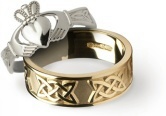History Of Ireland Symbols Explained
 |
 |
 |
| History of Ireland Ring | History of Ireland Bracelet | History of Ireland Ingot |
| Browse our History of Ireland collection | ||
 |
Circle of Life The Celtic swirl is found on Neolithic structures built throughout Ireland thousands of years ago. With no beginning and no end, this symbol represents the unwinding path we all thread through life. |
 |
Saint Patrick Saint Patrick, Ireland's patron saint, changed the course of Irish history early in the 5th century when he began his mission of converting Ireland to Christian religion. Saint Patrick has a special importance too as the author of the first document known to have been written in Ireland, he thus marks the transition from an oral to a written literature. |
 |
Round Towers From the 6th century onwards, as the Irish people embraced Christianity, great monastic centers were established all over the country. Each site centered around a Round Tower. Probably originally intended as bell-towers, they were soon needed for the storage of food and as places of refuge in times of invasion and persecution. |
 |
Vikings From the 9th to the 11th century the Vikings made repeated attacks around the coast of Ireland. An attempt to gain control of the whole country was defeated by Brian Boru at the Battle of Clontarf in 1014, however the Norsemen retained the towns they had established, notably Dublin, Wexford, Waterford, Cork and Limerick. |
 |
Norman Invasion In the 12th century the invaders were Norman, Flemish and Norman-Welsh, and their language and customs were French. Their 'over-lord' was the French-speaking Henry Angevin, who had, among his many titles, the important one of Henry II of England. This never became a 'Norman Conquest' but was used later as an excuse by the Tudor monarchs of England in their attempts at conquest. |
 |
Battle of the Boyne Protestant King William defeated his father-in-law, Catholic James II at the battle of the Boyne in 1690. In Europe this was seen as an important setback to French King Louis XIV and in England it meant the end of the Stuart monarchy. In Ireland the victory assured a Protestant ascendancy which would last for more than two centuries and is the cornerstone of the Irish problem today. |
 |
United Irishmen The Society of United Irishmen was founded in Ireland in the 18th century to seek parliamentary reform. The group evolved into a revolutionary republican organization and launched the Irish rebellion of 1798 with the objective of ending British rule. |
 |
Irish Flag Ireland's national flag is the tricolor of green, white and orange. Green represents the Gaelic tradition of Ireland and orange represents the supporters of William of Orange in Ireland. White represents the hope for peace between these two communities. |
 |
Famine The potato crops failed repeatedly during the 1840's causing widespread famine. The London government failed to alleviate the suffering, resulting in great bitterness towards the English nation and the ruling landlord classes. The famine was a watershed for the 'Irish' nation, changing forever its outlook and dispersing a large proportion of the population around the world. |
 |
Famine Ships Before the famine the Irish had been reluctant to emigrate, in the decades after the famine Irish emigration figures rose dramatically. Most went to the USA, some to Canada, and the bitterness felt by the Irish in America as well as those left at home had much to do with the subsequent hostile relations between England and Ireland. |
 |
GPO The Republic of Ireland was proclaimed from the General Post Office at the start of the Easter Rising, in 1916. The building was almost destroyed by fire and the rising was militarily a failure. The subsequent execution of the leaders of the rising provoked great anger, the Easter Rising thus triggered the War of Independence which eventually brought about the setting up of the modern Irish State. |
 |
Partition By the treaty of 1921, which ended the War of Independence, six of the counties of Ulster were separated from the rest of Ireland and became a province of the UK under the title 'Northern Ireland'. The 26 counties became 'the Irish Free State' and in 1948 the Irish Free State became 'The Republic of Ireland'. |
